Section 3.7E: Exercises
- Last updated
- Jan 17, 2020
- Save as PDF
- Page ID
- 33058
This page is a draft and is under active development.
( \newcommand{\kernel}{\mathrm{null}\,}\)
Section Exercise
Verbal
Exercise 1.6.1
How do you solve an absolute value equation?
- Answer:
-
Isolate the absolute value term so that the equation is of the form |A|=B. Form one equation by setting the expression inside the absolute value symbol, A, equal to the expression on the other side of the equation, B. Form a second equation by setting A equal to the opposite of the expression on the other side of the equation, −B. Solve each equation for the variable.
Exercise 1.6.2
How can you tell whether an absolute value function has two x-intercepts without graphing the function?
Exercise 1.6.3
When solving an absolute value function, the isolated absolute value term is equal to a negative number. What does that tell you about the graph of the absolute value function?
- Answer:
-
The graph of the absolute value function does not cross the x-axis, so the graph is either completely above or completely below the x-axis.
Exercise 1.6.4
How can you use the graph of an absolute value function to determine the x-values for which the function values are negative?
Exercise 1.6.5
How do you solve an absolute value inequality algebraically?
- Answer:
-
First determine the boundary points by finding the solution(s) of the equation. Use the boundary points to form possible solution intervals. Choose a test value in each interval to determine which values satisfy the inequality.
Algebraic
Exercise 1.6.6
Describe all numbers x that are at a distance of 4 from the number 8. Express this using absolute value notation.
Exercise 1.6.7
Describe all numbers x that are at a distance of 12 from the number −4. Express this using absolute value notation.
- Answer:
-
|x+4|=12
Exercise 1.6.8
Describe the situation in which the distance that point x is from 10 is at least 15 units. Express this using absolute value notation.
Exercise 1.6.9
Find all function values f(x) such that the distance from f(x) to the value 8 is less than 0.03 units. Express this using absolute value notation.
- Answer:
-
|f(x)−8|<0.03
For the following exercises, solve the equations below and express the answer using set notation.
Exercise 1.6.10
|x+3|=9
Exercise 1.6.11
|6−x|=5
- Answer:
-
1,11
Exercise 1.6.12
|5x−2|=11
Exercise 1.6.13
|4x−2|=11
- Answer:
-
{94,134}
Exercise 1.6.14
2|4−x|=7
Exercise 1.6.15
3|5−x|=5
- Answer:
-
{103,203}
Exercise 1.6.16
3|x+1|−4=5
Exercise 1.6.17
5|x−4|−7=2
- Answer:
-
{115,295}
Exercise 1.6.18
0=−|x−3|+2
Exercise 1.6.19
2|x−3|+1=2
- Answer:
-
{52,72}
Exercise 1.6.20
|3x−2|=7
Exercise 1.6.21
|3x−2|=−7
- Answer:
-
No solution
Exercise 1.6.22
|12x−5|=11
Exercise 1.6.23
|13x+5|=14
- Answer:
-
{−57,27}
Exercise 1.6.24
−|13x+5|+14=0
For the following exercises, find the x- and y-intercepts of the graphs of each function.
Exercise 1.6.25
f(x)=2|x+1|−10
- Answer:
-
(0,−8); (−6,0), (4,0)
Exercise 1.6.26
f(x)=4|x−3|+4
Exercise 1.6.27
f(x)=−3|x−2|−1
- Answer:
-
(0,−7); no x-intercepts
Exercise 1.6.28
f(x)=−2|x+1|+6
For the following exercises, solve each inequality and write the solution in interval notation.
Exercise 1.6.29
|x−2|>10
- Answer:
-
(−∞,−8)∪(12,∞)
Exercise 1.6.30
2|v−7|−4≥42
Exercise 1.6.31
|3x−4|≥8
- Answer:
-
−43≤x≤4
Exercise 1.6.32
|x−4|≥8
Exercise 1.6.33
|3x−5|≥−13
- Answer:
-
(−∞,−83]∪[6,∞)
Exercise 1.6.34
|3x−5|≥−13
Exercise 1.6.35
|34x−5|≥7
- Answer:
-
(−∞,−83]∪[16,∞)
Exercise 1.6.36
|34x−5|+1≤16
Graphical
For the following exercises, graph the absolute value function. Plot at least five points by hand for each graph.
Exercise 1.6.37
y=|x−1|
- Answer:
-

Exercise 1.6.38
y=|x+1|
Exercise 1.6.39
y=|x|+1
- Answer:
-
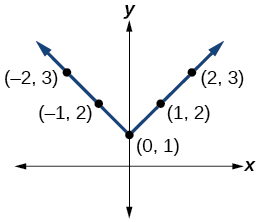
For the following exercises, graph the given functions by hand.
Exercise 1.6.40
y=|x|−2
Exercise 1.6.41
y=−|x|
- Answer:
-
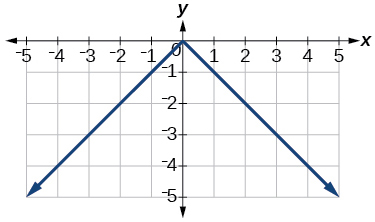
Exercise 1.6.42
y=−|x|−2
Exercise 1.6.43
y=−|x−3|−2
- Answer:
-
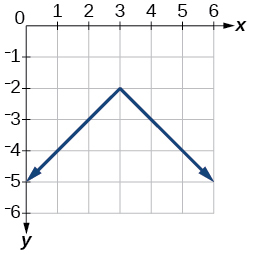
Exercise 1.6.44
f(x)=−|x−1|−2
Exercise 1.6.45
f(x)=−|x+3|+4
- Answer:
-
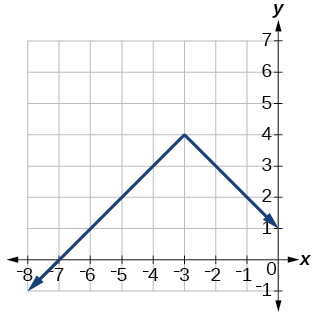
Exercise 1.6.46
f(x)=2|x+3|+1
Exercise 1.6.47
f(x)=3|x−2|+3
- Answer:
-
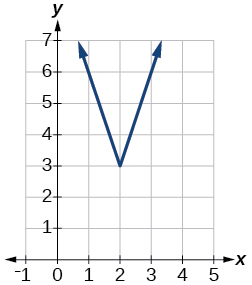
Exercise 1.6.48
f(x)=|2x−4|−3
Exercise 1.6.49
f(x)=|3x+9|+2
- Answer:
-
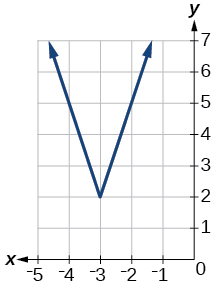
Exercise 1.6.50
f(x)=−|x−1|−3
Exercise 1.6.51
f(x)=−|x+4|−3
- Answer:
-

Exercise 1.6.52
f(x)=12|x+4|−3
Technology
Exercise 1.6.53
Use a graphing utility to graph f(x)=10|x−2| on the viewing window [0,4]. Identify the corresponding range. Show the graph.
- Answer:
-
range: [0,20]
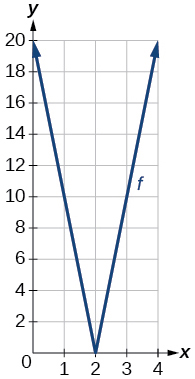
Exercise 1.6.54
Use a graphing utility to graph f(x)=−100|x|+100 on the viewing window [−5,5]. Identify the corresponding range. Show the graph.
For the following exercises, graph each function using a graphing utility. Specify the viewing window.
Exercise 1.6.55
f(x)=−0.1|0.1(0.2−x)|+0.3
- Answer:
-
x-intercepts:
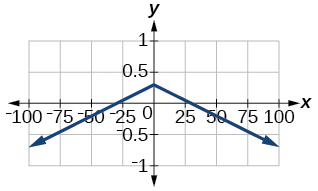
Exercise 1.6.56
f(x)=4×109|x−(5×109)|+2×109
Extensions
For the following exercises, solve the inequality.
Exercise 1.6.57
|−2x−23(x+1)|+3>−1
- Answer:
-
(−∞,∞)
Exercise 1.6.58
If possible, find all values of a such that there are no x-intercepts for f(x)=2|x+1|+a.
Exercise 1.6.59
If possible, find all values of a such that there are no y-intercepts for f(x)=2|x+1|+a.
- Answer:
-
There is no solution for a that will keep the function from having a y-intercept. The absolute value function always crosses the y-intercept when x=0.
Real-World Applications
Exercise 1.6.60
Cities A and B are on the same east-west line. Assume that city A is located at the origin. If the distance from city A to city B is at least 100 miles and x represents the distance from city B to city A, express this using absolute value notation.
Exercise 1.6.61
The true proportion p of people who give a favorable rating to Congress is 8% with a margin of error of 1.5%. Describe this statement using an absolute value equation.
- Answer:
-
|p−0.08|≤0.015
Exercise 1.6.62
Students who score within 18 points of the number 82 will pass a particular test. Write this statement using absolute value notation and use the variable x for the score.
Exercise 1.6.63
A machinist must produce a bearing that is within 0.01 inches of the correct diameter of 5.0 inches. Using x as the diameter of the bearing, write this statement using absolute value notation.
- Answer:
-
|x−5.0|≤0.01
Exercise 1.6.64
The tolerance for a ball bearing is 0.01. If the true diameter of the bearing is to be 2.0 inches and the measured value of the diameter is x inches, express the tolerance using absolute value notation.

